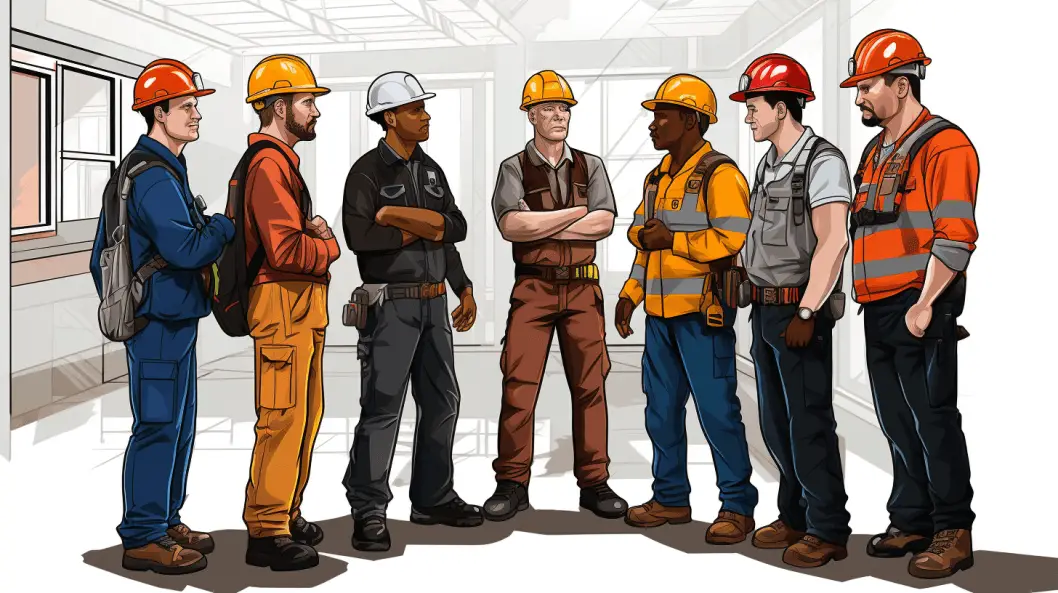Risk assessment is a crucial aspect of maintaining workplace safety and preventing accidents.
This article focuses on the concept of a ‘Risk Assessment Toolbox Talk,’ a tool designed to facilitate effective communication and understanding of risk assessment processes within a workplace setting.
In the ever-evolving landscape of risk management, having the right tools and techniques at your fingertips is more than just a convenience—it’s a vital necessity.
Risk touches every aspect of business, from the shop floor to the boardroom, and having the right approach can make all the difference.
Whether you’re a seasoned risk manager or a novice looking to sharpen your skills, this blog post will equip you with insights and tools to navigate the complexities of risk assessment with confidence and clarity.
Join us as we unlock the toolbox to turn risk from a threat into an opportunity!

What is Risk Assessment?
A Toolbox Talk aims to provide a platform for discussing safety-related topics and promoting worker awareness. These talks serve as a means of sharing information, educating employees, and reinforcing safe work practices.
Purpose of Toolbox Talk
A critical aspect of the risk assessment toolbox talk is to clearly define the purpose of this communication tool.
The toolbox talk aims to effectively communicate the risks and hazards associated with specific tasks or activities to the workers or employees.
This communication ensures that all workers know the potential risks and hazards they may encounter while performing their duties.
The toolbox talk also serves as a platform to discuss control measures that can be implemented to mitigate these risks and hazards.
By sharing information about past incidents and workplace injuries, the toolbox talk helps to raise awareness and promote a safer work environment.
Ultimately, the toolbox talk aims to empower workers to make informed decisions and take necessary precautions to prevent accidents and injuries.
Potential Hazards
This will focus on the types of hazards that can be present in the workplace and the unavoidable risks that may arise from these hazards.
Additionally, the process of identifying hazards in the workplace and assessing the level of risk associated with them will be explored.
Types of Hazards
Differentiating between various types of hazards is crucial in conducting a comprehensive risk assessment. When considering hazard identification and assessment, it is important to understand the different types of hazards present in a given situation. Some common types of hazards include:
- Physical hazards: These hazards involve the presence of objects or conditions that can cause harm, such as sharp edges, moving machinery, or extreme temperatures.
- Chemical hazards: These hazards involve the presence of chemicals that may be harmful to human health, such as toxic substances or flammable materials.
- Biological hazards: These hazards involve the presence of biological agents, such as bacteria or viruses, that can cause illness or infection.
To effectively prevent and control hazards, interim control measures can be implemented while permanent controls are implemented.
Adequate controls should be established to minimize the risk of hazards, including administrative controls such as training and procedures. Hazard reporting software can also be utilized to improve hazard recognition and ensure timely reporting of hazards.
Unavoidable Risks
Unavoidable risks are inherent in any environment or activity and require careful consideration to develop appropriate control measures. Risk assessment is crucial in identifying and managing workplace hazards, including avoidable and unavoidable risks.
While efforts should be made to eliminate or minimize common workplace hazards, certain risks cannot be eliminated. In such cases, it is important to have competent persons who can assess the risks and implement suitable control measures to mitigate harm to people.
Corrective actions should be implemented to address unavoidable risks and minimize them to the greatest extent possible.
A comprehensive risk assessment program, supported by training materials such as videos and clear policies, can help organizations effectively manage unavoidable risks in the workplace.
Identifying Hazards in the Workplace
Identifying hazards in the workplace requires a systematic approach that involves conducting thorough inspections, analyzing processes and procedures, and engaging employees in identifying and reporting potential hazards.
Organizations can utilize various strategies and tools to effectively identify workplace hazards, including implementing a risk assessment toolbox talk.
This toolbox talk is a platform for discussing workplace safety and encouraging employee engagement in hazard identification. The following are key elements to consider when identifying hazards:
- Conducting regular inspections to assess the workplace for potential hazards, such as unsafe environmental conditions or equipment malfunctions.
- Analyzing processes and procedures to identify areas where work-related incidents may occur, such as areas with poor ergonomic design or lack of proper training.
- Encouraging employee involvement by providing opportunities to report hazards and contribute to hazard identification efforts.
Assessing Level of Risk
To determine the level of risk associated with workplace hazards, organizations can employ a systematic approach that evaluates the potential harm or adverse effects that could result from exposure to these hazards.
This can be done through a risk assessment toolbox talk, which assesses workplace risk levels.
The assessment involves considering various factors such as the number of people exposed to the hazard, the type of equipment involved, and any records of previous incidents or near misses.
Potential hazards are identified and analyzed to determine the appropriate control measures and the need for personal protective equipment.
It is an ongoing process that requires the employer and employees’ active involvement to continually evaluate and mitigate the risk associated with common hazards in the workplace.
Risk Assessment Process
This discussion will focus on the key points related to the risk assessment process.
These key points include:
- The establishment of control measures.
- The appointment of competent persons for risk assessment.
- The monitoring and reviewing of risks.
- The establishment of corrective actions to reduce risk.
- The provision of training and education to staff on risk reduction.
Establishing control measures is crucial in minimizing potential hazards and ensuring a safe work environment.
Appointing competent persons for risk assessment helps to ensure that the assessment process is conducted accurately and effectively.
Monitoring and reviewing risks allows for continuous improvement and identification of new hazards.
Additionally, establishing corrective actions to reduce risk is essential in addressing any identified hazards and preventing accidents or incidents.
Lastly, providing training and education to staff on risk reduction is important in equipping them with the knowledge and skills necessary to identify and mitigate risks in their work environment.
Establishing Control Measures
One effective approach to mitigate risks in the workplace involves the establishment of control measures. These measures aim to minimize the occurrence and impact of potential hazards.
Here are three key aspects of establishing control measures:
- Environmental considerations:
- Assessing the workplace environment to identify potential risks.
- Implementing measures to address environmental hazards, such as ventilation systems to control air quality.
- Emergency preparedness:
- Developing emergency response plans and procedures to address unforeseen events.
- Ensuring the availability of necessary emergency equipment and resources.
- Material and housekeeping controls:
- Implementing procedures for the safe handling and storage of materials.
- Maintaining clean and organized workspaces to prevent accidents and injuries.
Organizations can effectively manage operational risks by incorporating these control measures and providing training to staff.
This can be achieved through qualitative risk analysis, which focuses on identifying and assessing risks, and quantitative risk analysis, which involves quantifying and prioritizing risks based on their likelihood and potential impact.
Appointing Competent Persons for Risk Assessment
Appointing competent individuals with expertise in risk identification and analysis is crucial for effectively implementing control measures in the workplace.
These individuals play a vital role in ensuring the safety and well-being of employees. By identifying potential risks and assessing their severity, they can mitigate hazards that could potentially harm lives or require medical attention.
One key tool in the risk assessment process is the risk matrix, which assigns a risk rating to each identified hazard. This allows for prioritization and efficient allocation of resources.
Risk assessment helps organizations understand the potential risks associated with specific tasks, enabling them to develop appropriate control measures.
Additionally, advanced risk assessment techniques, such as compliance risk assessments, can enhance workplace safety.
Effective risk assessment training is essential to equip these individuals with the necessary skills and knowledge to carry out their tasks effectively.
Monitoring and Reviewing Risks
Monitoring and reviewing risks is essential in ensuring the effectiveness of control measures implemented in the workplace. To effectively manage risks, organizations can utilize various assessment tools and techniques.
- Common risk assessment examples include identifying potential hazards, assessing the likelihood of severe injury, and evaluating the gravity of hazard identifications.
- Common risk assessment tools such as checklists, hazard operability analysis, and job safety analyses can be used to analyze and evaluate risks systematically.
- Worker engagement is crucial in the risk assessment process as it allows for identifying potential hazards and developing effective control measures.
Regularly monitoring and reviewing risks, organizations can identify any changes or new hazards that may arise in the workplace.
Incident investigation techniques can also be utilized to understand the causes of accidents and incidents, providing valuable insights for risk mitigation strategies.
This ongoing assessment of risks helps organizations maintain a proactive approach towards risk management and ensure the safety and well-being of their employees.
Establishing Corrective Actions to Reduce Risk
Corrective actions must be established to reduce risks identified through the risk assessment. These actions should address the requirements and potential hazards associated with specific work areas or tasks.
For example, if the risk assessment identifies loading docks as a high-risk area, measures such as implementing physical barriers or providing training on safe loading and unloading procedures can be implemented to reduce the risk of accidents.
The table below provides a visual representation of the details of risk assessments, including common traffic risks, hazards for control, worker exposure, and effective controls:
| Risk Assessment Details | Common Traffic Risks | Hazards for Control | Worker Exposure | Effective Controls |
|---|---|---|---|---|
| Loading Docks | Forklift accidents | Falling objects | Noise | Physical barriers, |
| Pedestrian collisions | Slips and trips | Chemicals | training | |
| Musculoskeletal | ||||
| disorders |
Providing Training and Education to Staff on Risk Reduction
Training and education programs can be implemented to equip staff with the necessary knowledge and skills to reduce risks in the workplace effectively.
Such programs can focus on various aspects related to risk reduction, including assessments of risk, external events risk, and specific hazards like biological hazards, chemical hazards, and construction site hazards.
The training can also cover topics related to exposure to health hazards and the control of premises. To effectively reduce risks, staff can be educated on the importance of engineering controls and how they can be implemented to mitigate potential dangers.
Additionally, the training should address the specific needs of construction workers, who often face unique risks.

Common Workplace Hazards
Loading docks and warehouses are important components of many businesses, serving as the hubs for receiving, storing, and distributing goods. However, these areas also pose various hazards that can cause injuries and accidents if not properly managed.
This discussion will explore the key points related to loading docks and warehouses, including the potential hazards, safety measures, and best practices for ensuring a safe and efficient working environment.
Loading Docks and Warehouses
Dock and warehouse areas present risks that must be carefully assessed and managed. To ensure the safety of workers and the smooth operation of these areas, it is crucial to identify and correct hazards promptly.
The severity of potential injuries can be reduced by applying controls such as implementing proper training, using personal protective equipment, and maintaining a clean and organized workspace.
Heavy equipment poses a significant risk, as a failure of a single piece of equipment can lead to serious accidents and unplanned equipment shutdowns. Routine equipment maintenance is essential to prevent such incidents.
Hazardous conditions, such as slippery surfaces or poor lighting, should be addressed promptly. Internal policies should be in place to promote a safety culture and ensure compliance with regulations and standards.
Frequently Asked Questions
What Are Some Examples of Risk Assessment Tools Can Be Used in the Workplace?
Risk assessment tools commonly used in the workplace include checklists, hazard analysis, job safety analysis, and audits. These tools help identify potential risks and assess the likelihood and severity of incidents to implement appropriate control measures.
How Often Should Risk Assessments Be Conducted in a Workplace?
The frequency of conducting risk assessments in a workplace should be determined based on various factors, such as the nature of the work, the complexity of the tasks, and any changes in the work environment or processes that may affect the level of risk.
What Are the Consequences of Not Conducting Regular Risk Assessments?
The consequences of not conducting regular risk assessments in a workplace can include an increased likelihood of accidents, injuries, and illnesses, potential legal and financial liabilities, decreased employee morale and productivity, and damage to the organization’s reputation.
Are Any Legal Requirements or Regulations Mandate Risk Assessments in the Workplace?
Legal requirements and regulations exist that mandate risk assessments in the workplace. These measures ensure the identification and mitigation of hazards, promote employee safety, and fulfil the duty of care employers have towards their workers.
How Can Employees Actively Participate in the Risk Assessment Process?
Employees can actively participate in the risk assessment by providing input and observations, reporting hazards and near misses, suggesting control measures, attending training sessions, and engaging in open communication with supervisors and coworkers.

Conclusion
Risk assessment is a crucial process in identifying and evaluating potential hazards in the workplace. By following a systematic approach, employers can minimize risks and ensure the safety of their employees.
Understanding common workplace hazards is essential for effective risk assessment. This includes physical hazards such as falls and chemical hazards like exposure to harmful substances.
Employers can create a safer work environment by implementing proper risk assessment procedures. Employers must prioritize risk assessment and take necessary measures to protect their workers.

Chris Ekai is a Risk Management expert with over 10 years of experience in the field. He has a Master’s(MSc) degree in Risk Management from University of Portsmouth and is a CPA and Finance professional. He currently works as a Content Manager at Risk Publishing, writing about Enterprise Risk Management, Business Continuity Management and Project Management.

